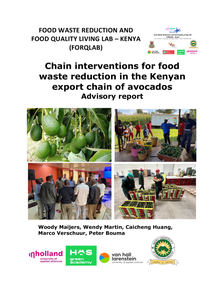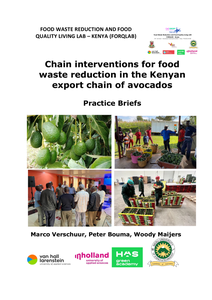Active antifungal packaging is a technological solution for reducing the postharvest losses of fruits and vegetables associated with phytopathogens. Anthracnose (Colletotrichum gloeosporioides) is the principal fungus that causes post-harvest avocado fruit decay. In this study, antifungal sachets filled with oregano oil-starch capsules were prepared, and their active effects were demonstrated on Hass avocado fruits. Oregano oil (31 % of carvacrol) was encapsulated with corn starch by spray drying. Tyvek sachets (4 × 4 cm) filled with 80 (T1) and 160 mg (T2) of oregano oil-starch capsules (99.35 ± 1.86 mg g − 1) were fabricated. The antifungal effects of the sachets were tested in vitro and in vivo using a humidity chamber (90–95 % relative humidity (RH)) on fruits inoculated with anthracnose. The results showed that T1 and T2 inhibited 75.21 ± 2.81 and 100 % in vitro growth of anthracnose at 25 °C for 12 days. Furthermore, Hass avocado fruits stored in a humidity chamber at 25 °C for 6 days showed that only T2 significantly (p < 0.05) reduced the area of lesion produced by artificial inoculation of Hass avocado fruits with anthracnose. On average, the lesion area in the Hass avocado fruits treated with T2 was 13.94 % smaller than that in the control fruit.
MULTIFILE
Active sachets can be used to manage postharvest losses associated with phytopathogens in fruit and vegetables. Diseases associated with phytopathogens are the principal causes of avocado losses postharvest. This study was performed to develop antifungal active sachet-based oregano oil microencapsulated with starch/agave fructans that allows in vivo and in vitro control of phytopathogens associated with avocado decay. In addition, avocado-sachet interactions were studied. Oregano oil sachets inhibited 100% of the in vitro growth of Colletotrichum gloeosporioides, Colletotrichum acutatum, Diaporthe passiflorae, and Neoscytalidium hyalinum at 30 °C for 12 d The efficacy of the oregano oil sachets was confirmed on avocados inoculated with C. gloeosporioides. Active sachets reduced the injury area of anthracnose infection in avocado without negative effects on the color or firmness of the fruit, compared to untreated control. Treatment also caused significantly higher (p < 0.05) phenylalanine ammonia-lyase, chitinase, β-1,3-glucanase, catalase and peroxidase activities compared to the control fruit. In addition, antifungal sachets significantly enhanced the contents of total flavonoids and phenolic compounds in treated avocados.
DOCUMENT
Consumers expect product availability as well as product quality and safety in retail outlets. When designing or re-designing fruit and vegetables supply chain networks one has to take these demands into consideration next to traditional efficiency and responsiveness requirements. In food science literature, much attention has been paid to the development of Time-Temperature Indicators to monitor individually the temperature conditions of food products throughout distribution as well as quality decay models that are able to predict product quality based upon this information. This chapter discusses opportunities to improve the design and management of fruit and vegetables supply chain networks. If product quality in each step of the supply chain can be predicted in advance, good flows can be controlled in a pro-active manner and better chain designs can be established resulting in higher product availability, higher product quality, and less product losses in retail. This chapter works towards a preliminary diagnostic instrument, which can be used to assess supply chain networks on QCL (Quality Controlled Logistics). Findings of two exploratory case studies, one on the tomato chain and one on the mango chain, are presented to illustrate the value of this concept. Results show the opportunities and bottlenecks for quality controlled logistics depend on product—(e.g. variability in quality), process—(e.g. ability to use containers and sort on quality), network- (e.g. current level of cooperation), and market characteristics (e.g. higher prices for better products).
DOCUMENT

Western-European consumers have become not only more demanding on product availability in retail outlets but also on other food attributes such as quality, integrity, and safety. When (re)designing food supply-chain networks, from a logistics point of view, one has to consider these demands next to traditional efficiency and responsiveness requirements. The concept ‘quality controlled logistics’ (QCL) hypothesizes that if product quality in each step of the supply chain can be predicted in advance, goods flows can be controlled in a pro-active manner and better chain designs can be established resulting in higher product availability, constant quality, and less product losses. The paper discusses opportunities of using real-time product quality information for improvement of the design and management of ‘AgriFood Supply Chain Networks’, and presents a preliminary diagnostic instrument for assessment of ‘critical quality’ and ‘logistics control’ points in the supply chain network. Results of a tomato-chain case illustrate the added value of the QCL concept for identifying improvement opportunities in the supply chain as to increase both product availability and quality. Future research aims for the further development of the diagnostic instrument and the quantification of costs and benefits of QCL scenarios.
DOCUMENT

With this project we strived to contribute to structural reduction of post-harvest food losses and food quality improvement in the Kenyan avocado and dairy value chains through the application of technical solutions and tools as well as improved coordination in those food chains. The consortium had four types of partners: 1. Universities (2 Kenyan, 4 Dutch), 2. Private sector actorsin those chains, 3. Organisations supporting those chains, and 4. Network partners. The applied research has been implemented in cooperation with all partners, whereby students at involved universities conducted most of the field studies and all other consortium partners support and interact depending on the phases.The FORQLAB project targeted two areas in Kenya for both commodities, a relatively well-developed chain in the central highlands and a less-develop chain in Western-Kenya. The research methods were the business to business and multi-stakeholder (living lab) approaches to increase the potential for uptake of successful interventions in the chain. The project consisted of four phases: 1. Inventory and inception, 2. Applied research, 3. Spreading research outputs through living lab networks, 4. Translation of project output in curricula and trainings. The outcomes were: two knowledge exchange platforms (Living Labs) supported with some advice for sustainable food loss reduction, a research agenda, proposals for ICT and other tech solutions and an implementation strategy; communication and teaching materials for universities and TVETs; and knowledge transfer and uptake.
DOCUMENT

This paper assesses the sustainability performance of the banana value chain by comparing and discussing 25 attributes owing to different sustainability dimensions. The paper identifies critical aspects and provides a qualitative assessment of the sustainabilityperformances of banana chains at the local level. The study finds economic, social, and environmental indicators have moderate sustainability performance in the Arba Minch, Ethiopia. The chain has an advantage in terms of profitability, employment, and emissionof air pollutants; and constraints in terms of coordination, value share, profit margins, market diversity, product and market information, transportation, waste management, and safety and hygiene.
DOCUMENT

This publication the avocado advisory report which is based on popular papers (practice briefs) of master and bachelor theses and business assignments of students at three Dutch Universities of Applied Sciences: Van Hall Larenstein (VHL), InHolland and HAS Green Academy, and Meru University of Science and Technology in Kenya. All 23 theses and business assignments were commissioned through the research project entitled “Food Waste Reduction and Food Quality LivingLab (FORQLAB)” in Kenya.
DOCUMENT

This booklet presents the practice briefs (popular papers) of master and bachelor theses and business assignments of students at three Dutch Universities of Applied Sciences: Van Hall Larenstein (VHL), InHolland and HAS Green Academy, and Meru University of Science and Technology in Kenya. All theses and business assignments were commissioned through the researchproject entitled “Food Waste Reduction and Food Quality Living Lab (FORQLAB)” in Kenya.
DOCUMENT

This chapter presents the currently not established and identifies design requirements for new systems to address this challenge and provide directions for possible improvement. As a result, this chapter introduces the concept of SamenMarkt®, a participatory system in which multi-agent system technology enables distributed price negotiation, distribution and communication between producers, retailers and consumers.
LINK